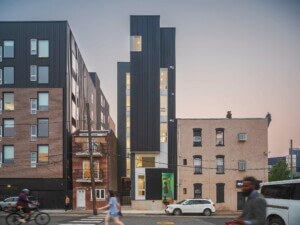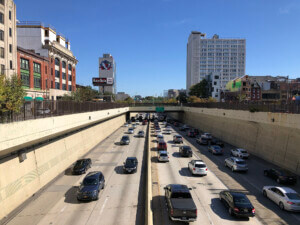Fernand Léger is famous for his colorful paintings, many of which feature machine-like forms. He was also at the center of Paris’ avant-garde in the 1920s, not only in painting, but also in graphics, set and costume design, film-making, and architecture.
That is the thesis of Anna Vallye, curator of this fall’s major exhibition at the Philadelphia Museum of Art, Léger: Modern Art and the Metropolis, inspired by the museum’s Léger masterpiece, the monumental 1919 painting, “The City.”
Léger was born in 1881 to a cattle farmer in Normandy, France. He trained as an architect and moved to Paris in 1900 to become an architectural draftsman, later transitioning to painting seriously in his mid-20s. He also served in the French army during World War I. When he returned from the front, he painted “The City,” an almost eight-foot-by-ten-foot “mural” painting that Vallye compares to Picasso’s pivotal 1907 work, “Les Desmoiselles d’Avignon.” She wrote in the exhibition catalogue, “If the ‘Desmoiselles’ is a world of fragments that converge in the ‘startled consciousness of (its) viewer’…’The City’ is a throbbing surface with no point of convergence, a bristling aggregate of equivalent signs (disk, pedestrian, letters, smoke) and formal effects.”
In the 1920’s, Léger socialized and sometimes collaborated with a wide-ranging group of artists and architects, whose works are on lavish display in this exhibition—of its approximately 180 works, only one-third are by Léger.
Thus, in the section focusing on what Vallye calls “publicity,” there are striking posters by Jean Carlu, Francis Bernard, and Cassandre for everything from a record company to a railway. Also here is a snippet of Abel Gance’s film, The Wheel, depicting close-up views of the wheels of a train in motion. Léger’s design for a poster for it is nearby. There is also Léger’s own experimental film, Mechanical Ballet, made in 1923 with Dudley Murphy and Man Ray. The film had no story line or script, but an array of often abstract images and a score by George Antheil for sixteen player pianos, three airplane propellers, a siren, and seven electric bells. And there are Léger’s ballet set and costume designs, such as his multi-colored, abstract, early 1920’s backdrop and accompanying costumes for the Ballets Suedois’ Paris production of “The Skating Rink,” themselves inspired, according to Vallye, by Charlie Chaplin’s 1916 film, The Rink.
The final section of the exhibition explores the influence of Léger’s architectural training on his later designs, as well as the interaction during the 1920s between architects like Le Corbusier and Robert Mallet-Stevens and furniture designer Eileen Gray with painters like Léger and Theo van Doesburg. Highlights here include a 1982 reconstruction, after the 1923 original, of van Doesburg’s and Cornelius van Eesteren’s model of the utopian de Stijl private house, an explosion into space of planes and primary colors, and similar designs for l’Architecture Vivante, an avant-garde architectural magazine by Gray, Jean Badovici, van Doesburg, van Eesteren, Vilmos Huszar, Le Corbusier, and his cousin, Pierre Jeanneret. The dialogue between Léger’s abstract 1924-25 “Mural painting” and more figurative 1926 “Accordian” and “Still Life (The Cameos)” paintings, with earlier still life paintings by Le Corbusier and his colleague, Amedee Ozenfant, is fascinating. For Léger, said Vallye, mural paintings were meant to be a “presence in space. They affect the way you experience the space around them, they are meant to dominate space. If you put a red couch in a room, it changes the temperature of the whole room. Léger wanted painting to do the same thing.”
Léger: Modern Art and the Metropolis, through January 5, 2014, at the Philadelphia Museum of Art, . It will be on display at the Correr Museum in Venice from February 8 to June 2, 2014.










